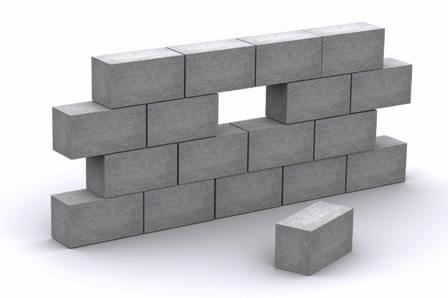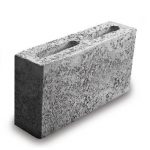
What are Solid Blocks ?
Solid blocks are dense, compact units made from various materials like concrete, cement, or lightweight aggregates. Unlike hollow blocks, solid blocks are uniform throughout their structure, offering a solid mass that contributes to their exceptional strength and load-bearing capacity.
Why You Need Solid Blocks in Construction:
- Structural Integrity: Solid blocks are renowned for their robustness, providing a strong and stable foundation for construction projects. Their density and uniform composition contribute to enhanced structural integrity, making them ideal for load-bearing walls and foundational elements.
- Sound Insulation: The dense nature of solid blocks aids in sound insulation, creating a quieter and more comfortable living or working environment. This quality is particularly valuable in residential and commercial construction.
- Fire Resistance: Solid blocks, especially those made from materials like concrete, exhibit excellent fire resistance. This characteristic enhances the safety of a structure, offering valuable time for evacuation in case of emergencies.
Importance of Solid Blocks:
- Longevity: Solid blocks contribute to the longevity of a building, as their durable composition withstands the test of time and environmental factors. This durability translates to reduced maintenance costs over the years.
- Versatility: Solid blocks find application in a myriad of construction projects, ranging from residential buildings to industrial structures. Their versatility makes them a preferred choice across various sectors.
- Energy Efficiency: The thermal mass of solid blocks aids in maintaining a consistent indoor temperature, contributing to energy efficiency. This can result in reduced reliance on heating and cooling systems.
Tips to Identify High-Quality Solid Blocks:
- Density and Weight: High-quality solid blocks tend to be denser and heavier. A simple physical examination can give an indication of their solidity.
- Uniformity in Size and Shape: Quality solid blocks are consistent in size and shape. Irregularities may suggest a lack of precision in the manufacturing process.
- Compressive Strength: Check the manufacturer’s specifications for the compressive strength of the solid blocks. Higher compressive strength indicates greater load-bearing capacity.
- Sound: Tap the block gently; a high-quality solid block produces a clear, ringing sound. A dull or hollow sound may indicate voids within the block.
What is the difference between solid blocks and hollow blocks ?
1. Structure:
Solid Blocks:
- Homogeneous throughout with no voids or hollow spaces.
- Designed for uniform density and strength across the entire block.
Hollow Blocks:
- Contain voids or empty spaces in the center, often in a honeycomb or grid pattern.
- The design with hollow spaces reduces the overall weight of the block.
2. Weight:
Solid Blocks:
- Typically heavier due to their solid composition.
- Greater mass contributes to higher compressive strength.
Hollow Blocks:
- Lighter compared to solid blocks due to the presence of voids.
- Lighter weight facilitates easier handling and transportation.
3. Applications:
Solid Blocks:
- Suitable for load-bearing walls, structural components, and areas where higher strength is required.
- Provides better sound insulation and fire resistance.
Hollow Blocks:
- Commonly used for non-load-bearing walls, partitions, and areas where weight reduction is important.
- Offers some degree of thermal insulation due to the air pockets within the block.
4. Insulation:
Solid Blocks:
- Generally better at providing sound and thermal insulation.
- The dense composition contributes to reduced sound transmission and improved temperature regulation.
Hollow Blocks:
- The voids can contribute to thermal insulation, providing some energy efficiency benefits.
- However, they may transmit sound more readily than solid blocks.
5. Cost and Construction:
Solid Blocks:
- May be more expensive due to the use of additional material and higher manufacturing complexity.
- Construction with solid blocks may require more labor.
Hollow Blocks:
- Often more cost-effective due to reduced material usage and lighter weight.
- Easier to handle during construction, potentially reducing labor costs.
6. Strength:
Solid Blocks:
- Generally have higher compressive strength, making them suitable for structural elements.
Hollow Blocks:
- While strong, they might have slightly lower compressive strength compared to solid blocks.
Uses of solid blocks of different dimensions:
- 4-Inch Solid Block:
Dimensions: 4 inches (height) x 8 inches (depth) x 16 inches (length)
Use: Commonly used for non-load-bearing walls, partition walls, and other applications where a thinner block is suitable.
5-Inch Solid Block:
Dimensions: 5 inches (height) x 8 inches (depth) x 16 inches (length)
Use: Suitable for both load-bearing and non-load-bearing walls, providing a balance between thickness and strength.
6-Inch Solid Block:
Dimensions: 6 inches (height) x 8 inches (depth) x 16 inches (length)
Use: Versatile block size suitable for various construction applications, including load-bearing walls and structural elements.
8-Inch Solid Block:
Dimensions: 8 inches (height) x 8 inches (depth) x 16 inches (length)
Use: Commonly used for load-bearing walls, foundations, and structural components due to its increased thickness and strength.
These dimensions are typical, but it’s important to note that variations may exist based on regional standards and specific product offerings from manufacturers. When sourcing solid blocks for a construction project, it’s advisable to consult with local suppliers or manufacturers to ensure you get the exact dimensions and specifications required for your specific needs.




